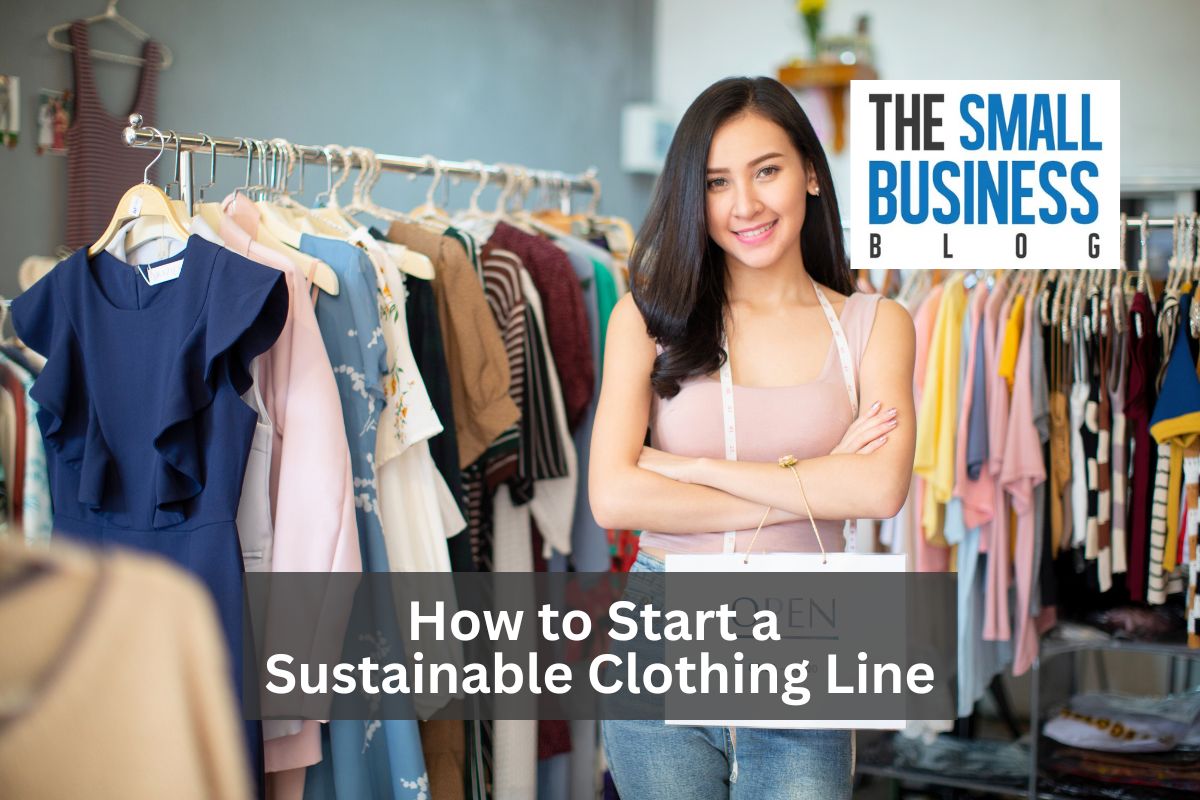Starting a sustainable clothing line is all about combining fashion with eco-consciousness.
In this article, we’ll walk you through the practical steps to teach you how to start a sustainable clothing line.
From defining your brand’s intentions at the beginning to the complex manufacturing process, we’ll cover it all.
Post Contents
- 1 How to Start a Sustainable Clothing Line
- 2 Marketing and Networking Your New Clothing Line For Success
- 3 Frequently Asked Questions
- 4 Conclusion
How to Start a Sustainable Clothing Line
The following are key steps and insights to start your new business venture successfully.
1. Define Brand Intentions

In the world of fashion, clarity of purpose is paramount.
Your brand intentions are the guiding stars that define your mission and set you on the path to making a meaningful impact.
Here’s how to navigate this crucial step:
- Mission Statement: Your mission statement should be a compelling declaration of your brand’s commitment to sustainability.
- Target Audience: To effectively establish your brand’s intentions, you must identify your target audience. Understanding their preferences, values, and aspirations will help tailor your approach.
- Ethical Values: Sustainably, moral values are the bedrock of your brand’s intentions. This includes principles such as fair labor practices, eco-conscious sourcing, and the reduction of environmental impact.
- Differentiation: To stand out in the saturated sustainable fashion market, your brand must find its unique selling point. What sets you apart? Is it your innovative materials, your commitment to the community, or your extraordinary design ethos?
By clearly defining your brand intentions, you create a solid foundation for your sustainable clothing line that resonates with consumers who value transparency and authenticity.
2. Come up with a Sustainable Product Idea
The heart of any sustainable clothing line lies in the products themselves.
Here, we explore how to come up with a product idea that not only reflects your brand’s commitment to sustainability but also meets the demands of the market:
Material Selection
The choice of materials is at the core of sustainability.
Consider opting for eco-friendly materials like organic cotton, hemp, Tencel, or even innovative materials like fabric made from recycled plastic bottles.
The key is to minimize the environmental impact of production while maximizing quality and comfort.
Innovative Design
Sustainable fashion is about creativity that reduces waste and maximizes utility.
Think of designs that are not just stylish but also functional.
Perhaps you can create convertible clothing for multiple purposes or designs with modular elements that allow customization.
Sustainability Features
Your product should embody sustainability in every thread.
Think about incorporating features like biodegradability, water-saving dyes, or upcycling.
These features not only make your products eco-friendly but also tell a compelling story to your customers.
3. Build Brand Identity
Crafting a brand identity is like shaping the face of your sustainable clothing line.
It’s how the world recognizes and remembers you.
Your logo and visual identity should reflect your brand’s core values.
Consider using earthy tones, natural imagery, or symbols that convey environmental consciousness.
A memorable logo can become a symbol of trust.
Share your journey, commitment to sustainability, and the challenges you’ve overcome, as it engages your audience personally and creates an emotional connection.
Your brand identity must be consistent across all touchpoints.
This includes your website, social media profiles, product labels, and even your packaging.
Consistency builds brand recognition and fosters trust.
4. Craft Designs

The design phase is where your ideas take shape and come to life.
To ensure a seamless transition from concept to product, consider these key aspects:
- Design Team: Surround yourself with a team of designers who are not only talented but share your vision for sustainability. Collaborate closely with them to bring your ideas to fruition.
- Prototyping: Before launching your clothing line, it’s crucial to create prototypes. This is the stage where you can test your designs, assess their practicality, and make necessary improvements.
- Quality Control: Maintaining quality is imperative in a sustainable fashion. Ensure that your manufacturing process includes rigorous quality control to maintain the integrity of your designs.
5. Manufacturing
Choosing the right manufacturing partners is pivotal to the success of your clothing line.
Decide whether to manufacture locally or overseas.
Local manufacturing reduces transportation emissions and supports local economies.
However, overseas manufacturing can provide cost-efficiency.
Weigh these factors carefully, keeping in mind your environmental goals.
Streamline your production process to minimize waste and enhance energy efficiency.
Innovative technologies, such as digital pattern-making and computerized cutting, can significantly reduce fabric wastage.
6. E-commerce and Sales Channels
Establishing a robust online presence is fundamental to the success of your clothing line.
The way you present and sell your products can have a profound impact on your brand’s reach and profitability.
E-commerce Platform
Choosing the right e-commerce platform is crucial.
It should be user-friendly, and offer features that align with your brand’s needs.
Popular choices include Shopify, WooCommerce, and BigCommerce, each offering various customizable options to create a unique online store.
Website Design
A visually appealing and easy-to-navigate website is essential for attracting and retaining customers.
Your website should reflect the same values of sustainability and transparency that your brand upholds.
This includes clear product descriptions, high-quality images, and an intuitive shopping experience.
Sales Strategy
Developing a robust sales strategy is a crucial component of your business plan.
It should encompass how you’ll attract and retain customers, reach new markets, and maximize your online presence.
Consider a mix of strategies, such as search engine optimization (SEO), content marketing, and social media advertising.
7. Sustainable Packaging

Sustainable packaging is more than just an eco-friendly trend—it reflects your brand’s commitment to environmental responsibility.
Choosing suitable packaging materials can make a substantial difference.
Opt for packaging materials that have a minimal environmental impact.
It includes using biodegradable bags, recycled cardboard, and soy-based inks.
Embracing a minimalist design philosophy for your packaging can help reduce waste, so consider simplified, reusable, and multi-purpose packaging solutions.
This approach minimizes the use of excess materials and can also lead to cost savings in the long run.
Create an unboxing process that surprises and delights customers.
Personalized notes, recycled tissue paper, and unique packaging designs can make a lasting impression and encourage brand loyalty.
8. Logistics Part
Efficient logistics and supply chain management are the gears that keep your sustainable clothing line running smoothly.
Implementing an efficient inventory management system helps reduce overstocking and minimize waste.
You should balance keeping enough stock to meet customer demand and avoiding excess inventory that may go unsold.
Selecting eco-friendly shipping partners is another step toward sustainability.
Look for carriers that offer carbon-neutral shipping options or utilize alternative fuels and efficient routing to minimize emissions.
Another thing you can do is develop a sustainable returns policy that not only benefits your customers but also minimizes waste.
Encourage customers to return items in their original condition, which can then be resold, reducing the environmental impact.
Marketing and Networking Your New Clothing Line For Success

Marketing your sustainable clothing line effectively involves a unique approach that aligns with your brand’s values.
It’s not just about selling products; it’s about storytelling and creating a community of like-minded individuals.
Influencer Collaborations
Partnering with influencers who share your brand’s values can expand your reach.
Influencers can authentically convey your brand’s commitment to sustainability to their followers, connecting you with a broader and more engaged audience.
Sustainable Networks
Joining sustainable fashion networks and communities allows you to connect with like-minded individuals and organizations.
These networks can provide valuable insights, support, and potential partnership opportunities.
Collaborative Projects
Collaborate with other brands or organizations on eco-conscious projects.
Joint initiatives can amplify your impact and introduce your brand to new audiences.
Events and Fairs
Participating in eco-friendly events and fairs provides a platform to showcase your brand and connect with customers who share your values.
It’s an excellent way to introduce your sustainable clothing line to a broader audience.
Frequently Asked Questions
Can I start a sustainable clothing line with a limited budget?
Yes, it’s possible to start small and grow gradually.
Look for grants, loans, or investors who share your vision, and explore cost-effective materials and manufacturing options.
How do I find sustainable fabric suppliers?
Research and network within the sustainable fashion community.
Attend eco-friendly trade shows and connect with suppliers specializing in eco-conscious materials.
Is it necessary to have a physical store for my sustainable clothing line?
No, many successful sustainable clothing brands operate solely online.
However, having a physical store can enhance brand visibility and customer experience.
What are some eco-friendly packaging options for shipping clothing?
Eco-friendly packaging includes recycled cardboard boxes, biodegradable poly bags, and reusable packaging options.
Conclusion
As we conclude this guide on how to start a sustainable clothing line, you’ve been equipped with the insights to go on a path that fuses fashion and responsibility.
Starting a sustainable clothing line is a journey that requires dedication, creativity, and a commitment to eco-conscious values.
Remember, sustainability isn’t just a trend; it’s a commitment to fashioning a better world for all.
Now, go forth and let your sustainable clothing line be a testament to your values and vision.






























